Introduction
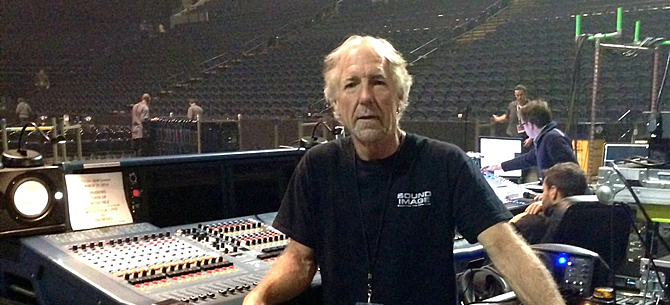
Greetings and welcome to the OptogateSolutions Website! My name is Terry Nelson, I am a Professional live and Studio Sound Engineer. I have been in the industry for almost 40 years making records and mixing live concerts for many number one artists. In that span of time I have worked for many incredible artists in which I wish I had Optogates in my audio tool kit!
I brought these incredible infrared vocal gates to the USA-Canada and Mexico market as the exclusive Optogate distributor in 2005. The response has been fantastic and I have had the pleasure to supply hundreds of Optogates from Arena Stars to Club Stars. It makes no difference what professional level you are at. They work in all live environments. If you’re looking for a clean, clear sound coming from your vocal mics, look no further! This is the only product on the market with the incredible plug and play Infrared Technology. Once you try them live, you won’t be able mix shows without them.
Review of Optogate PB-05 and PB-07 written by Mike Crofts for Sound on Sound Magazine
Every once in a while, along comes a neat little trick that makes live sound work a bit more fun. In this case it’s called the Optogate: a handy little plug-on microphone mute switch, which has been around for a while now, but somehow I’ve never met one until the other week when a couple arrived in the post for me to take a peek at. Optogate are a German company who make a range of useful audio add-ons, presumably starting with the Optogate device itself, but now including products such as cable testers, a mains over-voltage protector, and even a motorised attachment for raising and lowering mic stands remotely during a performance. Anyway, back to the Optogate, of which there are different versions available. The PB-05 and PB-07 I looked at are similar in terms of both operation and physical appearance.
The Problem
Someone famous once said that technology only advances when there’s a problem to be solved, and one very common issue with live sound is the ‘open mic’. I’m not talking about the ‘bring-your-own-guitar-and-beard’ type of open mic, but the one on a live stage that is necessary but doesn’t need to be used for the whole show, or where the user — be it singer or instrumentalist — tends to step away from the mic during their performance.
The obvious answer is to either turn the mic in question off manually (which can be tedious and relies heavily on the engineer remembering to do so, and then remembering to turn it on again) or to use some form of automatic gate. Normal audio gates are fine once set up correctly, but as they respond to sound levels and it’s the sound we’re trying to either amplify or eliminate at any given time, it’s often difficult to arrive at a setting that operates the gate at exactly the right moments.
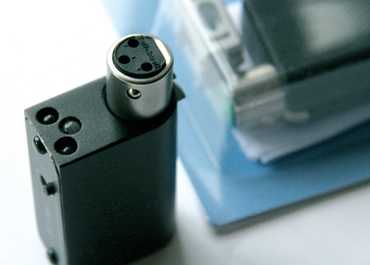
The Solution
The Optogate uses a different approach, in that it is triggered by the physical presence or absence of the mic user. The PB-05 has a miniature infrared transmitter and receiver, which detects reflected IR from a person or instrument directly in front and noiselessly switches the signal from the mic on and off accordingly. The PB-05 is built into a small metal case, slightly smaller than a common-or-garden matchbox, and it incorporates a female XLR on one end and a male on the other. Another way of describing it would be as an XLR ‘through’ adaptor with a little square extension on the side. It mounts directly to the end of the microphone, and the mic lead plugs into the output connector. The end of the device facing the performer — the female (input) XLR end — houses the infrared transmitter and receiver LEDs, and a discreet red LED indicates that the PB-05 is switched on (ie. allowing the signal to pass through).
The only user control is a tiny push-button on top of the unit, which is a manual override switch so that the user can switch the mic on and disable the Optogate function. The Optogate works on 48V phantom power, which is passed through to the mic input. It works with dynamic or condenser mics, although when using dynamics you have to remember that phantom power is always on and seen by the mic — not a problem so long as everything is balanced.
Finding the Range
A small multi-turn potentiometer inside the Optogate — accessed via a tiny hole in the casing, so a very small screwdriver is required — is used to set the range at which it will react to an object. Turning it all the way anti-clockwise will set it to the shortest range, which is a few centimetres, and the longest range it will reliably work at is 120cm. The range also depends on the reflective properties of the ‘target’ — the Milk Tray guy would probably have to be a bit closer, whereas someone dressed in a silver suit and boots should do more reflecting.
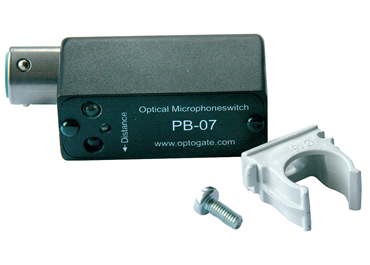
Testing Time
An obvious application for the PB-05 on a live sound stage is the horn section, who don’t play all the time (at least the ones in my band don’t), and they tend to move away from their mics when they have nothing much to do. I was road testing some speakers with a function band who just happened to have a sax player, who also happened to spend some numbers on keyboards or hitting a tambourine — a perfect test! As the PB-05 is so small and light, it doesn’t really affect the mic position or balance at all and it’s hardly noticeable from a few feet away. I set it up by playing a few bars of air sax, and I was impressed by the fast and consistent response as indicated by the little red LED. Having got over the ‘Look at this — isn’t it clever how it does that?’ phase, the band got on with their soundcheck and the proper sax player, Laura, got on the mic for real.
I had found it very easy to set up the PB-05, and to be honest I was expecting it to be a bit hit-and-miss at first, but it was completely reliable in operation. Once I had got the setting right, it never missed an ‘on’ or ‘off’, either during the soundcheck or for the rest of the night. There is no discernible switching noise, and the (open) Optogate doesn’t have any noticeable effect on the signal passing through. I can remember thinking, ‘Why don’t I own some of these?’ because the Optogate completely eliminates unwanted open stage mic worries and can play a large part in cleaning up a live mix.
Try this at Home
As with any brilliant idea, though, there are a couple of limitations. The aforementioned remark about what the performer is wearing is a real issue, but easily overcome, and I didn’t find this a problem at all on short-range settings, even in my boring black shirt. It’s always going to be difficult if the player/singer moves around a lot when they are actually using the mic, but singing or playing at a stage mic from more than a metre away is pretty unlikely anyway. More of a problem might arise from ambient lighting — either stage lights or direct sunlight — and the user guide does warn about this (it even invites you to try an experiment with your home hi-fi remote!). But again it should be relatively easy to position mics away from direct bright lights or infrared sources.
I can see a major benefit in using Optogates at outdoor functions where various dignitaries and celebs tend to suddenly loom up to a mic and expect it to work immediately. With this little box installed, they can loom all they want and the engineer can relax for a change. All that ‘Is it on?’ tap, tap... ‘Is anyone there?’ tap, tap... stuff could be a thing of the past!
The override switch, which toggles between ‘Optogate’ and ‘always on’ modes, is a useful enough feature, but the trouble with user-accessible features is that users tend to discover and use them. If a performer manages to switch their PB-05 to ‘always on’ (permanently un-muted), the engineer can reset the unit by switching off its phantom power for a few seconds. When phantom is restored, the PB-05 will boot up in its operational ‘Optogate’ mode and all will be well. This could also be useful as a remote switching function when using dynamic mics, as the Optogate defaults to ‘signal through’ when no power is applied to it, so simply switching on phantom power will mute an unattended mic direct from the desk.
Variations on a Theme
If mounting the Optogate directly on the back of the microphone isn’t practical, there’s another model called PB-07, which comes with a plastic clip for attaching directly to a mic stand so that the Optogate sits vertically. On this model, the infrared TX and RX lenses are on the flat panel, so the unit is positioned facing the performer and can be completely hidden from the audience — just another option, which may be useful in TV or video applications, or when miking up orchestras where space is at a premium. On the version sent to me, the PB-07 wasn’t equipped with the manual on/gate switch and I was quite happy to use the PB-05 model.
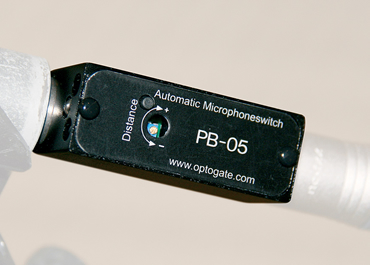
Conclusion
After using the Optogate on just one gig, I reckon it is an extremely useful device, and it is now in my ‘almost essential’ category of live sound accessories. It’s clever, it’s neat, it’s a real problem solver, and it actually works. The Optogate is most definitely on my Christmas and birthday lists, and I think the dog wants one too...
The Artists I have done business with are too many to mention but here are a few:

Doobie Brothers
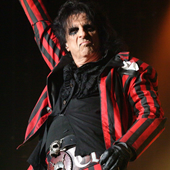
Alice Cooper

Guns N´ Roses

Red Hot Chilli Peppers
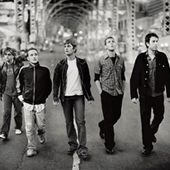
Matchbox Twenty

Neil Young

Uli Jon Roth

Whitesnake

Meatloaf

Van Halen

Alan Parsons Project

GooGoo Dolls

Brooks And Dunn

Montgomery Gentry
Your typical open mic worries could be a thing of the past, as these optical microphone switches operate in response to the physical presence or absence of the performer in front of the mic, helping to clean up your live mix.
Mike Crofts from Sound On Sound Magazine
Review of the Optogate PB-05 and 07
